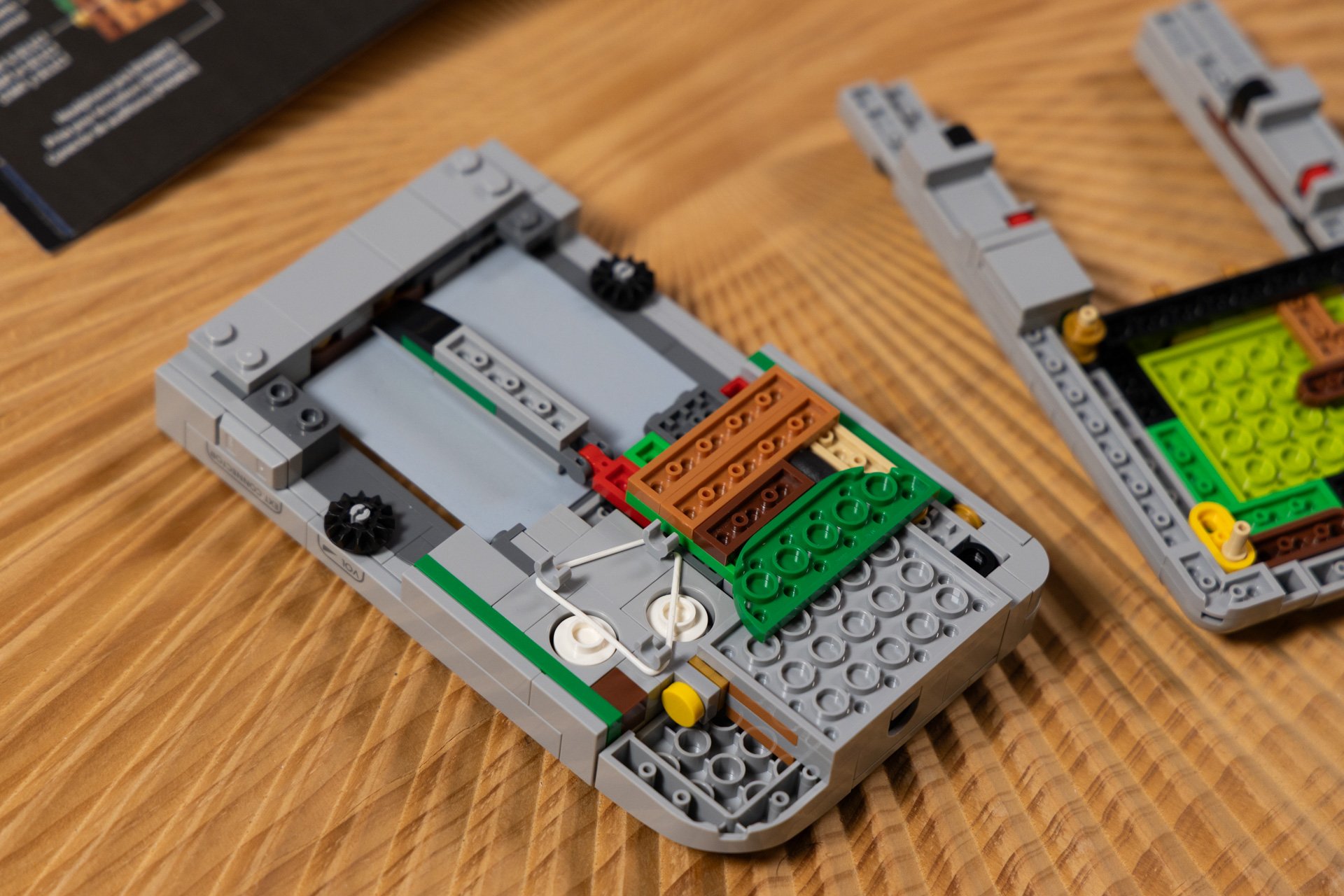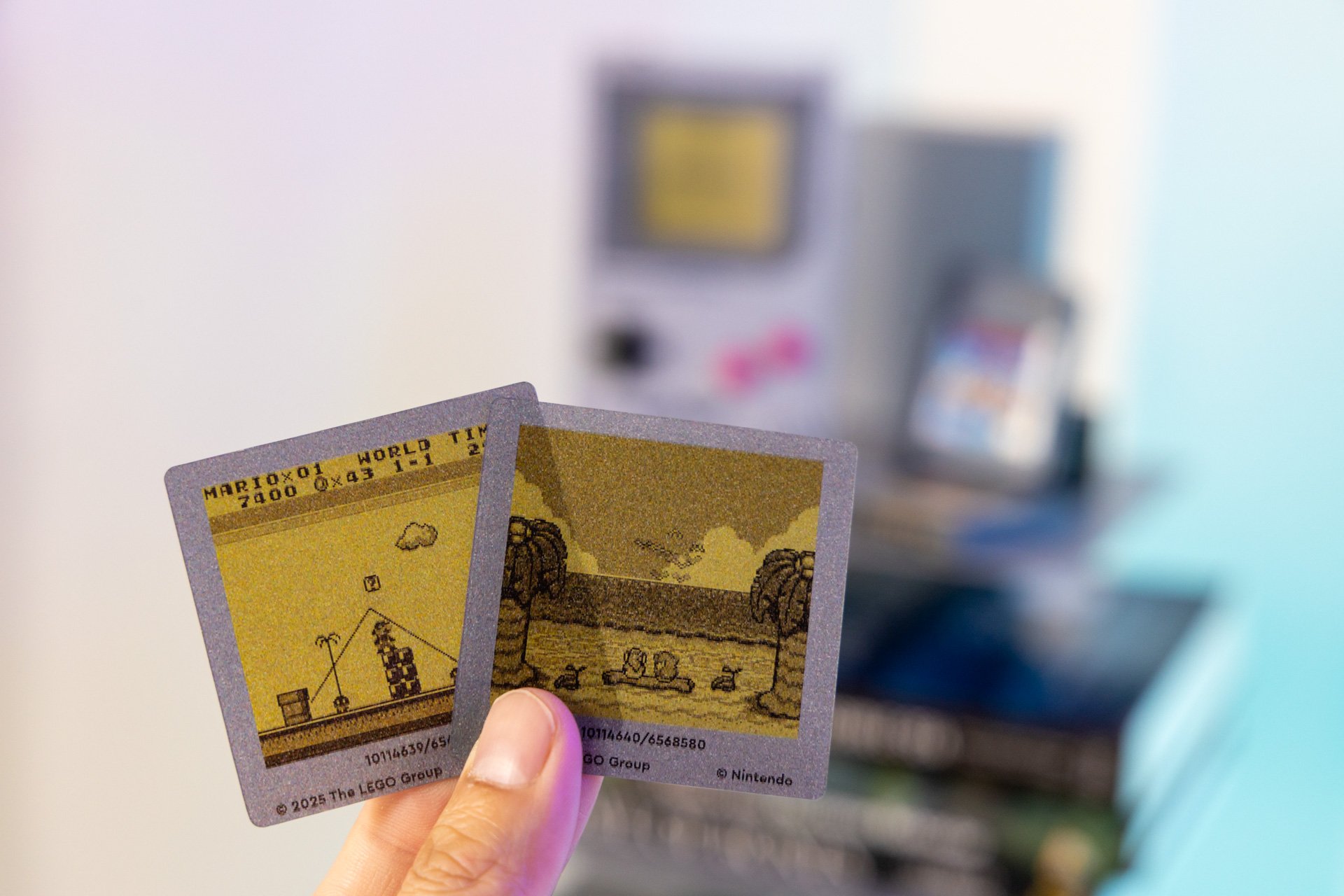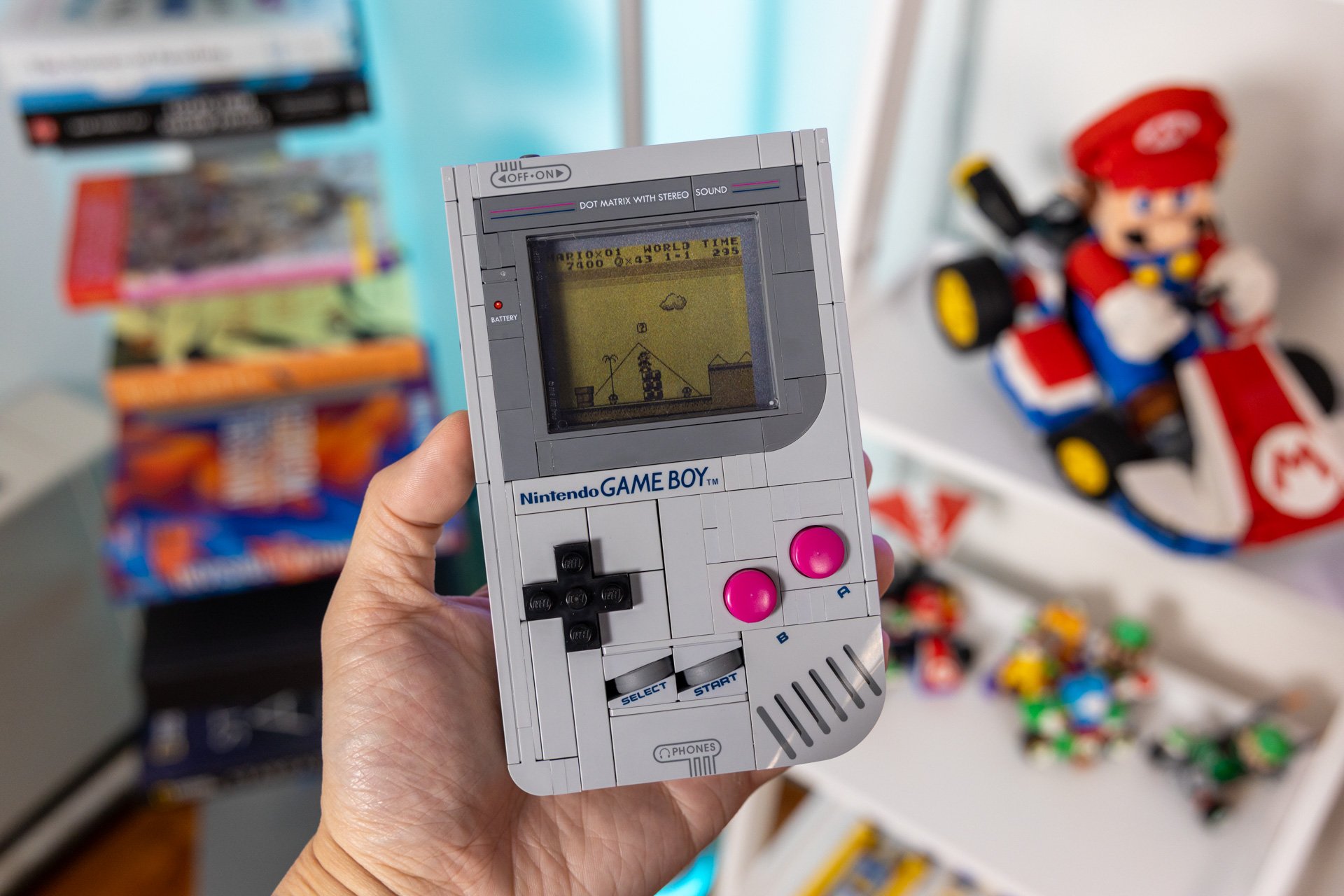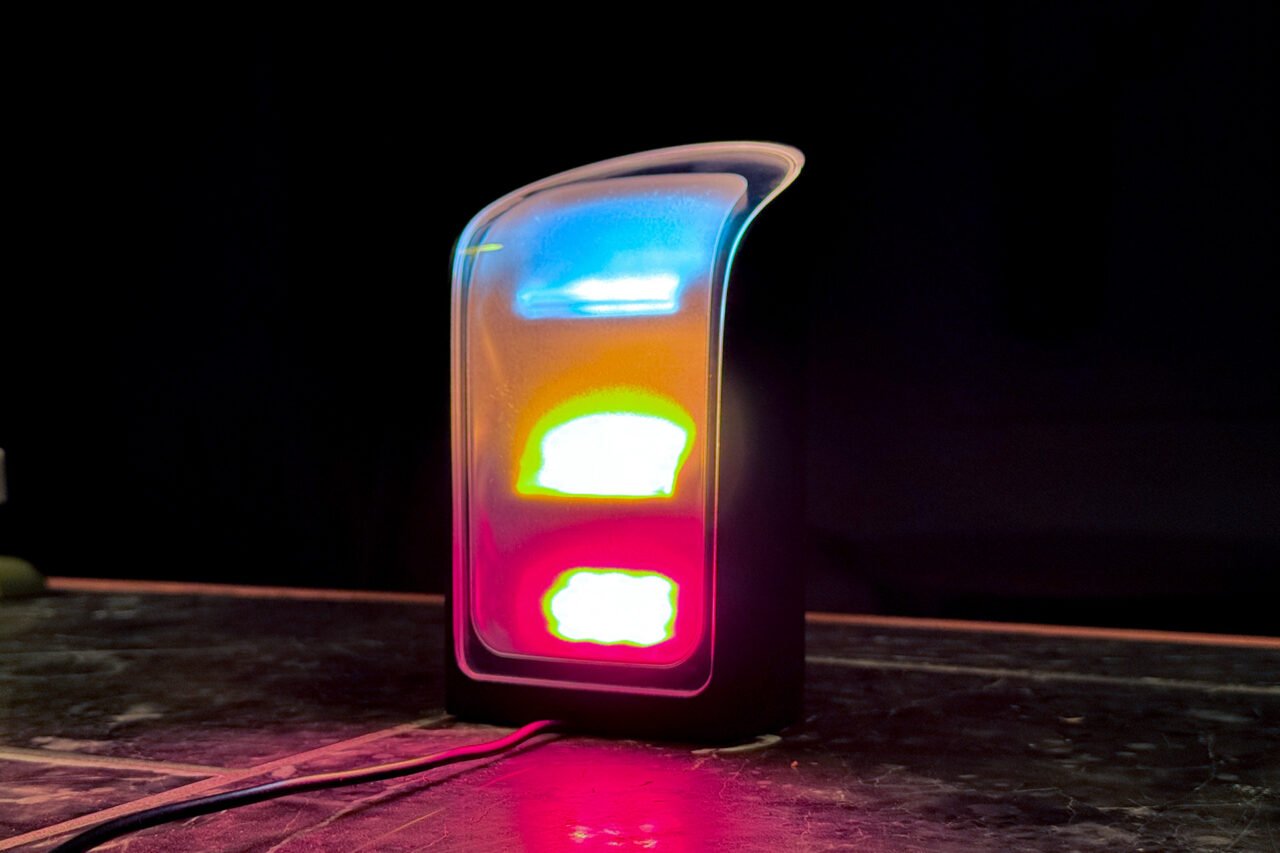I owe the original Game Boy everything. Had it not been for Nintendo’s gray brick of a handheld, and a copy of Super Mario Land, I doubt I would be writing these words on Gizmodo. It was the gadget that started my lifelong obsession with cutting-edge technology and my passion for sharing it with others. So excuse me for being overwhelmed with emotion and nostalgia when Lego announced it was making a 421-piece brick set version of the iconic Nintendo handheld.
Released on Oct. 1 for $60, the Lego Game Boy is a pretty easy build. Lego says it’s for ages 18+ and up, but there was nothing complicated enough that a 10-year-old couldn’t follow the instructions. (Though, they wouldn’t have any nostalgia for the handheld that came out in 1989.) It took me about 1 hour and 15 minutes to complete, but I think it would have taken under an hour if I hadn’t stopped to shoot B-roll for a social video. (It’s all fun and games building Lego sets after work; this is also work for me.)
Lego Game Boy
Lego's Nintendo Game Boy is easily one of the most fun brick sets of the year.
Pros
- Easy to build
- Pressable buttons, wheels, and switches
- Nearly 1:1 replica
- Includes lenticular screens and Game Paks
- Affordable
Cons
- Building it is over too soon
As I noted in my hands-on a few weeks earlier, the Lego Game Boy is more than just a charming—and almost 1:1 replica—display piece. In addition to the pressable buttons, scrollable dials, and the slideable power switch, you can also pop in brick versions of Super Mario Land and The Legend of Zelda: Link’s Awakening game cartridges into the Lego Game Boy. Remove the back cover and you get access to swap in three different lenticular screens featuring the two games and the Game Boy’s famous bootup screen featuring the Nintendo logo sliding down.
@raywongtech The Lego Game Boy is so freaking cool! Check out my review and interview with Lego Senior Designer Carl Merriam and Design Director Simon Kent, who worked on the 421-piece Lego Game Boy set to learn how they developed it from start to finish. There’s so much that went into designing not just how it looks on the outside, but the inside too. Like the way the buttons and switches work, the brickified circuit boards inside the Game Paks, and more. Also, will there be Lego SNES, N64, and more sets? #lego #nintendo #gameboy #foryou #toys
There are tons of Easter eggs inside the Lego Game Boy that make it more than just a skin-deep recreation. I spoke with Carl Merriam, a senior designer at the Lego Group, and Simon Kent, a design director at the Lego Group, who worked on the Lego Game Boy set to unearth some of its unseen secrets.
Designing the Lego Game Boy

There’s been some strongly worded opinions about which company gets credit for the Lego Game Boy. Is it Lego or is it Nintendo? The answer is both—as it should be. Nintendo is famous for being extremely protective of its IP—its products, franchises, and characters are well-guarded and require top-level approval. To do a Lego version of the Game Boy, Merriam and Kent had to go beyond just the outer gray shell and pink buttons.
“Nintendo was very involved,” Kent, who’s been at Lego for almost 20 years, told Gizmodo. “We have a team that works in Japan… they basically allow us to connect to different IP teams or hardware teams or even creative teams within Nintendo to get the right information to make the product as best as it can be. We also met with the hardware designer that I think may have worked on the original or certainly was connected to the original [Game Boy].”
Merriam, a senior designer who’s been at Lego for 12 years, started as a fan before landing at the toy company. He’s worked on Lego sets, including Boost, Minecraft, and Super Mario, to name a few popular series. For the Game Boy, which he says took around a year from concept to development, the team went through 10 to 20 iterations before landing on the final design and tweaking it to feel extra special, extra Nintendo-y.
The dimensions of the Game Boy proved to be restrictive in what Lego could do, but in the end, I would say it’s semi-faithful to the actual handheld, which has to be commended.
@raywongtech Lego Game Boy unboxing and timelapse build! #lego #nintendo #gameboy #fyp #gaming
“We don’t really have a lot of room in here to do a lot of stuff, and we played around with all kinds of different functional ways to make you be able to do something with the games,” Merriam told Gizmodo. “It turned out that the one thing that we could achieve all over the entire thing was making all of the buttons have the same haptic feedback as the actual device, or as close as we can get in Lego bricks.”

He said each area of the Lego Game Boy was a design challenge on its own. Merriam says he probably built 30 to 40 versions for the way the D-pad, buttons, and switches. I noticed that attention to detail as I built the Lego set. Behind the D-pad is actually a little rubber piece that gives it a springiness when you press into it. Same goes for the A and B buttons; those are actually minifig hats painted pink, and there’s a little rubber band behind them that gives them a familiar button travel when pressed. The start and select buttons are black tire pieces changed to gray, and they date back to 1969, Kent told me. Comparing the Lego Game Boy controls with my original Game Boy that my mom bought in 1993, I gotta say it’s impressive how hard Lego went to replicate it.

I asked how they approached building the Lego Game Boy—did they 3D model it first or just get right to building? How do you even go about choosing the pieces, though? It’s estimated that there are tens of thousands of unique Lego pieces available to use. With an entire vault going back almost 70 years to select from, where do you even start? Sure, Lego could—and it did—create a few new, custom parts for the Game Boy, but where’s the creativity in making many new parts?
“My mind is built of the Lego system, so whenever I see anything in the real world, I see a Lego piece that maybe could be that thing,” Merriam said. He explained to me how the clear panel for the Lego Game Boy screen is actually a window frame that’s “quite an old piece,” and it was a good problem to have to design it so that it would be centered properly.

As for the custom pieces… well, you could try to find out which one it is, or I could just tell you. It involves one of the corners of the Lego Game Boy.

“We wanted to sort of incorporate everything that was mobile about the Game Boy,” added Kent. “We had discussions—should we do any peripherals that can plug into it? Should it come with some headphones? Should it come with a little light [like the Game Boy Light Magnifier]? But, in the end, we wanted to keep it simple and focused very much on… taking their favorite games and playing them anywhere.”
Speaking of games, the insides of the cartridges, or Game Paks as they’re officially called, were something that came later on in the process, after they finished making the outer case and making sure all the functions worked. In the Zelda game cart, there’s a “save battery” piece that replicates the way Game Paks preserved your game progress.

One burning question I had to ask the two was what the joint/kickstand-like piece that keeps the lenticular screens in place is called. “I call it a dingler, I don’t have a technical term for it,” Merriam told me. So there you have it, it’s unofficially called a dingler!

More Lego Nintendo consoles coming?
The Game Boy is the second Nintendo console that Lego brickified. The first was the Lego NES set released in 2020. That set was larger, had more pieces, and was more expensive. Kent says the Lego Game Boy was an attempt at a Nintendo set that’s more affordable.
“For a long time, the team in general has wanted to do the Game Boy, and we felt that now was probably the right time, and we also wanted to explore a different price point,” Kent said. “Obviously, the NES came with a TV. It’s a higher price point, so we wanted to do something smaller to test that area.”

I tried to get Merriam and Kent to tell me whether there are more Lego Nintendo consoles on the way, but they wouldn’t let anything slip. So if you’re waiting for a Lego SNES, N64, or GameCube, you’ll just have to keep waiting.
Pure joy and fun

When I first saw the Lego Game Boy, I was both excited and curious to see how it would differ from the many fan creations out there. I was surprised—or maybe I shouldn’t have been—that Merriam and Kent didn’t look at the fan creations out there.
“If you search for anything related to intellectual property, there’s probably a Lego version of it out there somewhere,” Kent said. “We are very careful for that exact reason. We deliberately don’t look at fan-related material because we want to focus on the actual real thing and do what we think is the right thing with the partner who we are collaborating with.”
“One of the most interesting differences between being a Lego fan and the Lego designer is that we’re designing a product for people to build at home, and to make the experience of building the product fun is a totally different challenge than just making something look like the source material,” said Merriam.

At the end of the day, the Lego Game Boy—or any Lego set, really—should be fun to build. Yes, I often speed build Lego sets, but that usually comes at the expense of enjoying all the care that went into designing not just how the completed build looks on the outside, but the inside.
There’s honestly not much to dislike about the Lego Game Boy set. If there’s anything to nitpick, it’s that the transparent screen was a little scuffed out of the box, and I wish the lenticular cards were more visible. But then again, the original Game Boy’s monochromatic green screen was a pain to look at from any angle other than dead center, too. For a weekend build that only costs $60, this is the most fun you’ll have in a long time, especially if you’ve got any nostalgia for the Game Boy.
“The Lego system is like a language,” Merriam said. “I like to try to write poetry with the Lego system. Every once in a while, I can achieve it, and I believe I’ve achieved it in this one.”












